In a filing with the Tennessee Valley Authority (TVA), xAI, an artificial intelligence startup that Elon Musk helped create, has laid out plans for constructing a small solar farm next to its Colossus data center in Memphis, bringing on-site generation to one of the world’s most power-hungry AI training facilities.
The company sent local planners information on an 88-acre array it would place to the west and south of the campus. By industry-standard power densities, the project would generate about 30 megawatts (MW) at peak production, with a 136-acre developer-owned lot adjacent to the site that could be used for potential future growth.

A Modest Addition to a Very Big Load at Colossus
Thirty megawatts is a significant amount for an on-site array, but it’s tiny compared with what Colossus is projected to consume. Based on the company’s own measurements, the solar field would only be enough to light up a bit less than 10 percent of the data center’s instantaneous power consumption at peak sun. On an energy basis per year, the fraction will be much lower: with a regional capacity factor perhaps in the 18%–22% range, a 30 MW installation could sell perhaps 50–60 gigawatt-hours of output per year versus the uninterrupted full-time draw of a modern AI training campus.
Still, colocated solar can shave peak grid demand, cut line losses, and expedite interconnection if it ties into the same substation that serves the facility. For utilities and grid operators, those qualities become ever more precious as compute loads grow and feeders approach thermal limits.
Local Footprint and Context on the Regional Grid
The site plan utilizes adjacent land connected to the data center, minimizing land-use approvals and facilitating construction. It asked ETC to immediately start on a project that can be up and running in six months to two years while MLGW evaluates additional solar and transmission capacities; placing some of that capacity already behind the meter can help with local congestion as well as hedge against delays associated with attempting to connect to the interconnection.
Yet the small size points to a larger truth: AI facilities with multi-hundred-megawatt demand profiles will rely predominantly on utility-scale resources, not simply behind-the-fence solar, if they are to both decarbonize and firm their power supply.
Turbines, Pollution, and Local Backlash in Memphis
xAI’s aggressive commitment to power has also come under scrutiny for its temporary use of natural gas turbines. The Southern Environmental Law Center, in partnership with the NAACP, claims the company has run more than 400 MW of gas capacity without valid permits, and that at least 35 turbines there are capable of each annually emitting over 2,000 tons of nitrogen oxides. Those emissions help form smog and cause respiratory ailments.
Neighbors in nearby Boxtown, a largely black community that has historically shouldered a more than proportional share of industrial burdens, cite deteriorating air quality. A 79% peak increase in nitrogen dioxide concentrations near the data center was observed at the University of Tennessee, Knoxville, after the facility commenced operations. Local authorities have given temporary approval to a small number of turbines; xAI has said the units are assumed to be a bridge while additional grid power and green energy is found.

Larger Clean Energy Package in the Works
Additionally, xAI has earmarked a proposed 100 MW solar project supported by 100 MW of grid-scale batteries to firm output and enable the plant to operate more closely as a baseload contributor, independent of solar input.
The initiative is being developed with the Seven States Power Corporation, which was awarded a $439 million financing package — a significant slice of it in interest-free loans — by the U.S. Agriculture Department to help move the project along.
Built as described — and that will be the big if for this project — the solar-plus-storage combination would do more to offset the data center’s round-the-clock load profile, especially during evening peaks when straight solar drops off entirely. And it would be in step with the broader industry trend toward 24/7 carbon-matching approaches rather than annual balancing of renewable energy credits.
Growth and Emissions Outside of Memphis at Colossus 2
xAI is also installing turbines in Mississippi for its Colossus 2 supply hub, where there are 59 machines on site and some being called temporary. Environmental groups warn that official emissions inventories may understate the true footprint of pollution by these short-lived units, which are often not fully tracked by regulators, complicating community oversight and public health assessments.
What It Means for AI Power Strategy and Siting
The contrast could not be starker: a small on-site solar project next to load in the hundreds of megawatts, accompanied by emergency gas with which to ensure training clusters remain lit. Energy agencies and labs, ranging from the International Energy Agency (IEA) to Lawrence Berkeley National Laboratory, have simply noted that data center electricity demand growth is enormous these days: AI training clusters commonly suck down 30–50 MW each and hyperscale campuses can easily exceed that. As demand for computing grows, decisions about siting, placement in interconnection queues, and local air quality impact are as significant to AI competitiveness as chip supply.
For Memphis, the solar farm next door is an overt step toward a clean supply, and also a test of whether modest amounts of on-site generation can be reconciled with community health priorities. The larger questions are no longer about intent: how fast large solar-plus-storage comes online, how transparently turbine emissions get regulated down until they flatline, whether xAI signs up for auditable 24/7 clean energy procurement that effectively reduces local pollution along with global carbon.

